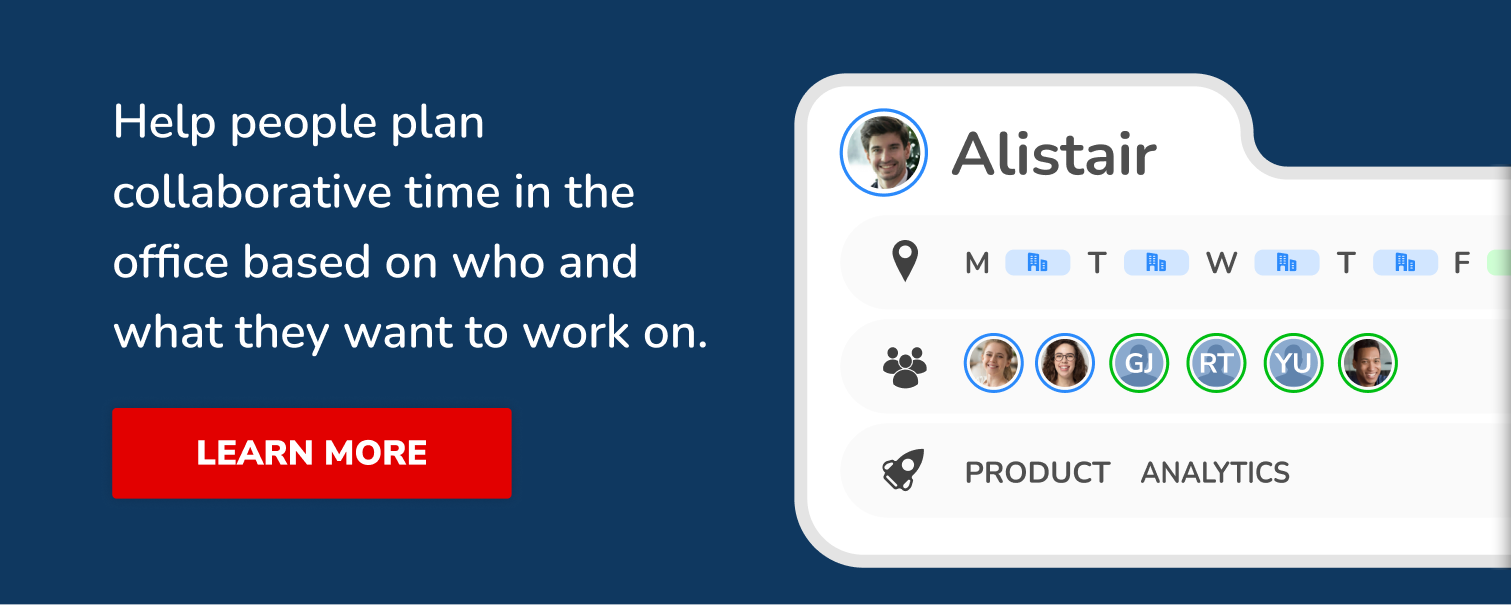Did you know that on average, office space is now only being used at 50-60% capacity compared to pre-pandemic levels?1 The rapid shift to hybrid work has left many organisations grappling with how to adapt their workspaces. Challenges like wasted space, difficulties with collaboration, and employee dissatisfaction are common as companies navigate this new reality.
But here's the good news: with intentional strategies, you can optimise your hybrid office to boost productivity, foster connection, and attract talent back on-site. In this article, we'll walk through 8 proven ways to make your hybrid workspace work harder and smarter for your team. Let's dive in!
Strategy 1: Assess Current Space Utilisation
The first step to maximising your hybrid office is understanding how it's currently being used - or underused. Leveraging data analytics, you can uncover key insights like:
- Office attendance patterns: What % of employees are coming in and how often?
- Desk, zone or meeting room usage: Which spaces are in high demand vs. sitting empty?
- Peak usage times: When is your office busiest and quietest?
By tracking metrics like occupancy rates, you can identify spaces that are consistently underutilised and could potentially be repurposed, allowing you to downsize and save on real estate costs. One company that implemented hybrid workplace analytics was able to reduce their office footprint by 30% without impacting employee experience.
To get started, consider investing in hybrid office space analytics software or a hybrid desk booking tool that can provide real-time and historical data on how your space is being used. This data-driven approach is key to making informed decisions about your space.

Strategy 2: Implement Hybrid Desk & Space Software
In a hybrid office, the old model of one desk per employee no longer makes sense. Enter hot desks or desk zones. This system allows employees to reserve a workspace in advance through a software platform.
The benefits are threefold:
- Prevents desk shortages and "space wars" when more people come in
- Improves space utilisation by avoiding large amounts of vacancies
- Empowers employees to choose where they'll work based on their needs, who they want to work with and preferences
Hybrid desk booking tools also offer presence or schedules of who plans to be in the office when so employees can plan who to be in the office with. Plus, the data collected by hybrid desk booking software provides valuable insights into usage patterns that can inform your space planning decisions. You may find that certain types of desks or areas are more popular and adjust your layout accordingly.
One global financial services firm implemented desk zone booking across their portfolio and saw space utilisation increase from 60% to 85%. Employee satisfaction with the booking process was over 90%.
When rolling out desk booking, be sure to set clear policies around cancellations, no-shows, and how far in advance employees can book. Provide training sessions to help employees adopt the new system and get the most value from it.
Strategy 3: Create Flexible, Multi-Purpose Spaces

One of the keys to a high-performing hybrid office is flexibility. By designing spaces that can be easily reconfigured for different uses, you can accommodate the diverse needs of your hybrid workforce.
Consider investing in modular furniture, movable walls, and adaptable rooms that can transition from a focused work area to a collaborative meeting space in minutes. For example, a lounge with comfortable seating can double as a casual brainstorming zone or a space for small team meetings.
These agile workspaces foster the kind of spontaneous collaboration and interaction that remote employees often miss out on. They also allow you to maximise your square footage by serving multiple purposes throughout the day.
One tech company redesigned their office with flexibility in mind and saw a 25% increase in space utilisation. Employees reported feeling more energised and engaged in the dynamic environment.
Strategy 4: Invest in the Right Technology
Seamless collaboration between in-office and remote employees is essential for hybrid team success. That's why investing in the right technology is a must.
Outfit your meeting rooms with high-quality video conferencing equipment, digital whiteboards, and wireless content sharing capabilities. This ensures that virtual participants can engage just as effectively as those in the room.
Consider solutions that integrate with your other workplace tech stack, like desk booking software, so employees can easily find and reserve a space with the amenities they need.
Don't forget about your remote employees' home office setups. Providing furniture and reliable tech equipment shows that you value their well-being and productivity equally to your in-office staff.
By managing your technology centrally and providing ample IT support, you can create a frictionless digital experience for your entire distributed workforce. One study found that organisations with strong hybrid work tech strategies saw a 21% boost in employee performance.

Strategy 5: Prioritise Employee Health and Wellbeing
Healthy employees are productive employees. And after the challenges of the past few years, workers are placing an even higher premium on wellbeing in the workplace.
Incorporate ergonomic furniture, abundant natural light, and biophilic design elements like plants and nature-inspired textures to create a comfortable and calming environment. Designate quiet zones for focused work and social spaces for relaxation and connection.
Providing amenities like healthy snacks, fitness classes, or meditation rooms can also entice employees to come on-site. One survey found that 69% of employees would give up other benefits for better workplace wellness offerings.
The key is creating spaces that support both physical and mental wellbeing. When employees feel good in the office, they're more likely to view it as a destination rather than an obligation. And that translates to higher engagement, productivity, and retention in the long run.
Strategy 6: Establish Clear Hybrid Work Policies
To ensure your optimised office is used effectively, it's crucial to set clear guidelines around hybrid work. Establish policies on when and how often employees are expected to come on-site. Some key questions to address:
- Will certain teams or roles need to be in the office more than others?
- Are there core "in-office" days for collaboration or key meetings?
- How will you ensure fairness and consistency in policy application?
Transparent communication is essential here. Employees should understand the reasoning behind the policies and feel that they are being applied equitably. Consider providing training sessions on how to make the most of your hybrid office, from booking spaces efficiently to collaborating effectively with remote colleagues.
One study found that organisations with clearly defined hybrid work policies saw 27% higher employee performance than those without. So don't leave it up to chance - set your team up for success with a well-structured hybrid work model.
Strategy 7: Gather Employee Feedback Regularly

Your employees are your most valuable source of insight when it comes to your hybrid workspace. Regularly seek their feedback to understand what's working well and where there are opportunities to improve.
Conduct surveys to gather quantitative data on satisfaction with the office environment, technology tools, and hybrid policies. Complement this with focus groups or informal conversations to dive deeper into qualitative insights.
Involving employees in design decisions can also drive engagement and a sense of ownership over the space. Consider forming a hybrid workplace committee with representatives from different teams to provide ongoing input.
By actively listening and iterating based on employee feedback, you can create a workspace that truly meets the needs of your unique workforce. One organisation that implemented quarterly employee pulse surveys saw a 32% increase in hybrid office utilisation and a 20% boost in employee satisfaction scores.
Strategy 8: Experiment and Embrace Flexibility
The reality is, there is no one-size-fits-all approach to the hybrid office. What works for one organisation may not work for another. The key is to embrace a spirit of experimentation and continuous improvement.
Pilot different space configurations, technology solutions, and hybrid work models to see what resonates with your team. Treat your office as a living lab, where you can test and learn rapidly.
Regularly assess your data on space utilisation, employee feedback, and business metrics to identify what's moving the needle. Don't be afraid to course-correct if something isn't working - flexibility is the name of the game in the hybrid world of work.
By staying agile and adaptable, you can create a hybrid office that evolves with your organisation's needs over time. One company that adopted this experimental mindset saw a 19% increase in employee engagement and a 14% reduction in turnover.
Conclusion
Maximising your hybrid office space is about so much more than just desks and meeting rooms. It's about creating an environment that empowers your employees to do their best work, whether they're in the office or remote.
By leveraging data analytics, investing in the right technology and amenities, and prioritising employee wellbeing, you can transform your office into a true destination - a place where people want to be.
Remember, the most successful hybrid workplaces are those that are flexible, adaptable, and employee-centric. So start small, experiment often, and never stop iterating. Your team (and your bottom line) will thank you.
The future of work is hybrid - is your office ready?
About Author
Graham Joyce is co-founder of DuoMe, a flexible working advocate and a frequent panellist/commentator on the issues of flexibility or hybrid working.







